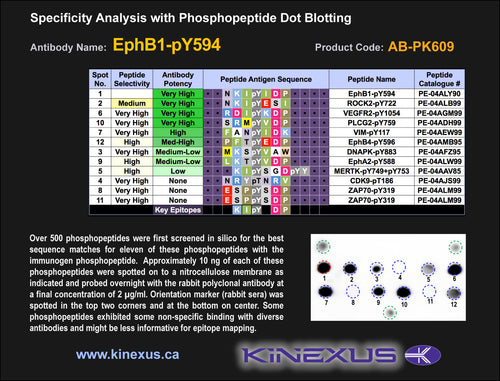Product Name:
EphA3-pY779
Product Number:
ab-pk609
Target Full Name: Ephrin type-A receptor 3 protein-tyrosine kinase
Target Alias: EPA3; Eph receptor A3; Ephrin type-A receptor 3; ETK; ETK1; HEK; HEK4; Kinase EphA3; Tyrosine-protein kinase receptor REK4; TYRO4; CCDS2922.1; ENSG00000044524
Product Type Specific: Protein kinase phosphosite-specific antibody
Antibody Code: PK608
Antibody Target Type: Phosphosite-specific
Antibody Phosphosite: Y779
Protein UniProt: P29320
Protein SigNET: P29320
Antibody Type: Polyclonal
Antibody Host Species: Rabbit
Antibody Immunogen Source: Human EphA3 sequence peptide Cat. No.: PE-04AGN65
Antibody Immunogen Sequence: EAA(pY)TTR(bA)C
Antibody Immunogen Description: Corresponds to amino acid residues E776 to R782; In protein kinase catalytic domain activation T-loop between subdomains VII and VIII.
Production Method: Corresponds to amino acid residues E776 to R782; In protein kinase catalytic domain activation T-loop between subdomains VII and VIII.
Antibody Modification: Protein kinase phosphosite-specific antibody
Antibody Concentration: 0.4 mg/ml
Storage Buffer: Phosphate buffered saline pH 7.4, 0.05% Thimerasol
Storage Conditions: For long term storage, keep frozen at -40°C or lower. Stock solution can be kept at +4°C for more than 3 months. Avoid repeated freeze-thaw cycles.
Product Use: Western blotting | Antibody microarray
Antibody Dilution Recommended: 2 µg/ml for immunoblotting
Antibody Species Reactivity: Human
Antibody Positive Control: The observed molecular mass of the processed target protein on SDS-PAGE gels is reported to be around 120-130 kDa.
Related Product 1: EphA3-pY779 blocking peptide
Related Product 2: EphA1-pY781 phosphosite-specific antibody (Cat. No.: AB-PK605)
Related Product 3: EphA2-pY588 phosphosite-specific antibody (Cat. No.: AB-PK606)
Scientific Background: EphA3 is a protein-tyrosine kinase of the TK group and Eph family. It is a receptor kinase that binds ephrin ligands to induce contact signalling. It is activated by binding ephrin-A1, A2, A3, A4 or A5. Phosphorylation of Y596, Y602 and Y779 increases phosphotransferase activity and interaction with Crk. Upregulation of EphA3 is common in lung cancer and melanomas. Its mutation pattern in human tumours is very characteristic of a tumour suppressor protein.This pathway can regulate cell adhesion, migration, and movement. EphA3 function is inhibited and EFNA5 binding interrupted with the V133E, and F152L mutations. EphA3 is linked to Pleomorphic Rhabdomyosarcoma, which is a rare disease which is related to colorectal cancer, and can also affect the uterus, heart, and skeletal muscle tissues.


